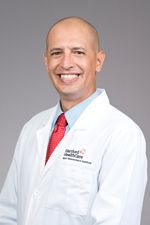<< Back
Why This Neurosurgeon Relocated to U.S. to Perform Complex Spine Cases

April 21, 2021
The main difference between practicing medicine in his native Brazil and the United States, according to neurosurgeon Dr. Pedro Coutinho, is technology allowing him to operate on spines precisely through the tiniest incisions.
“We definitely have access to cutting-edge intraoperative technology here. Today, I was able to use our new ‘toy,’ the Kinevo 900 Microscope with three 3D screens so the entire staff working with me can see exactly what I’m seeing,” wrote Dr. Coutinho in an Instagram post after the procedure. “That’s a game-changer.”
 Dr. Pedro Coutinho
Dr. Pedro Coutinho
Dr. Coutinho, part of the growing team at the Hartford HealthCare Ayer Neuroscience Institute Spine Wellness Center, specializes in complex spine cases. After working for 10 years in Rio de Janeiro, he brought his family to the United States to improve his skills. For the benefit of his four children, though, he opted to stay, completing two clinical fellowships, one at the University of Miami and the second at Yale.
At the Spine Wellness Center, he felt kinship with a multidisciplinary surgical team that is adept at surgery but chooses nonsurgical options whenever possible. Those options include physical therapy, pain management, nutrition counseling and health psychology, all working to eliminate such causes of spine pain as obesity, chronic health conditions and depression.
“We want to provide A to Z care,” Dr. Coutinho said. Patients come in “on both tips of the spectrum – those who want surgery but don’t have surgical indications and those who don’t want surgery but need it. We tailor treatment to each patient, respecting their decisions.”
A surgical innovator, he is happy working with teams open to novel techniques for performing neurological surgeries, such as the first endovascular surgery through the radial (wrist) artery recently performed by one of his partners at St. Vincent’s Medical Center.
“This was a newer technique allowing us to treat a malformation in the skull without opening the skull. Instead, you go in through the vessels. Traditionally, it was done through the femoral artery in the leg but now you can do it through the radial vein in the wrist,” he explained.
Advances in surgery allow him to perform more minimally-invasive procedures in the spine, which is less risky for patients and offers faster recovery. In the tight spaces around the nerves and spinal cord, high-powered microscopes help him maneuver deftly.
“We use the microscope to do big surgeries without causing big harm because they magnify small areas,” Dr. Coutinho said. The surgical robot “helps us place hardware very precisely through small incisions.”
On his Instagram account, @pedro_coutinho_md, he chronicles many cases. For the one using the new microscope, for example, he wrote, “The case: a thoraco-lumbar (T12-L2) saccular extradural tumor resulting in medullary conus and nerve root compression. Thankfully, the lesion came out in one single piece with no complications.”
Operating-room photos posted with his comments demonstrate the team’s cohesion.
“It’s rare to find something like the Spine Wellness Center,” he said of the non-surgical focus of care. “It might be somewhat frustrating for us because we like to operate but, to treat all patients, you need to have a multi-disciplinary approach focused on conservative management and that’s what we have.”
While his extended family remains in Brazil – his children speak only Portuguese at home so they can communicate with them – Dr. Coutinho settled into Fairfield, finding “good Brazilian bakeries” and playing forward on a state championship men’s soccer team.
“Probably the best decision I made in my life was to come to the United States. I am super grateful,” he said.